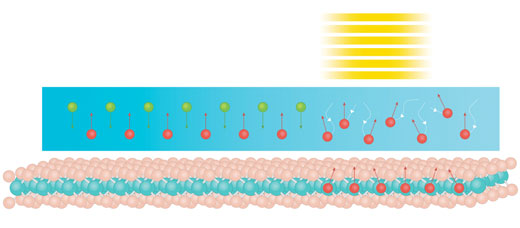| Apr 30, 2019 | |
A shot in the arm for spintronics(Nanowerk News) A simple and efficient method for transferring the currents produced by spinning electrons from metals to semiconductors has been developed by A*STAR researchers, laying the groundwork for faster and more energy efficient spintronic computers (Nature Physics, "Far out-of-equilibrium spin populations trigger giant spin injection into atomically thin MoS2"). |
|
| Although advances in electronics have led to increasingly powerful computers, the electrical resistance of silicon limits the rate — known as the clock speed — at which computers can process information to just a few gigahertz or several operations per nanosecond. | |
| Using the spin of electrons instead of their charge to convey information could overcome this limitation. Additionally, these so-called spin-currents consume less energy than electric currents, making spintronic computers more energy efficient than conventional electronic computers. | |
| Transferring spin-currents from one material to another, however, has proved very challenging as the currents can become scrambled during transportation, destroying the information they carry. | |
| Now, Justin Song from A*STAR’s Institute of High Performance Computing and colleagues from the Institute of Materials Research and Engineering, in collaboration with an international team of researchers, have developed a simple technique that significantly improves the efficiency at which spin-currents are injected from a magnetized metal into a semiconductor. | |
| “While methods exist for spin injection from metals into semiconductors, a key issue is that they typically operate close to equilibrium,” explains Song. “As a result, when a simple ferromagnet/semiconductor interface is used, the spin injection efficiency is low.” | |
| By heating a ferromagnet, made from cobalt, with pulses of light from a laser, the researchers were able to create spin-polarized electrons with a range of different energy levels in the cobalt, a state referred to as ‘out-of-equilibrium’, and in which their spins mostly point in the same direction. | |
| This out-of-equilibrium state generates spin-current pulses that last less than one trillionth of a second – enough time for them to diffuse from the cobalt into a semiconductor made from single-atom layers of molybdenum disulfide, which then converts the spin-current into an electric current. | |
 |
|
| Out-of-equilibrium excitation can enable efficient spin injection from a ferromagnetic metal (Co) into a semiconductor (MoS2). (Image: A*STAR Institute of High Performance Computing) | |
| "Possibly the most striking aspect is that all this was demonstrated using a simple metal-semiconductor interface, without the complicated and costly structural engineering used in other spintronics," says Song. | |
| The work establishes a new and simple technique for spin injection that is more than 10,000 times more efficient than what’s available now, and represents a significant step towards the development of ultrafast spintronic computers that use spin-currents as carriers of information, with clock speeds more than a thousand times faster than those in existing conventional computers. | |
| “We are now investigating how pushing systems into an out-of-equilibrium state can lead to effects not possible at equilibrium,” says Song. |
| Source: A*STAR | |
|
Subscribe to a free copy of one of our daily Nanowerk Newsletter Email Digests with a compilation of all of the day's news. |
